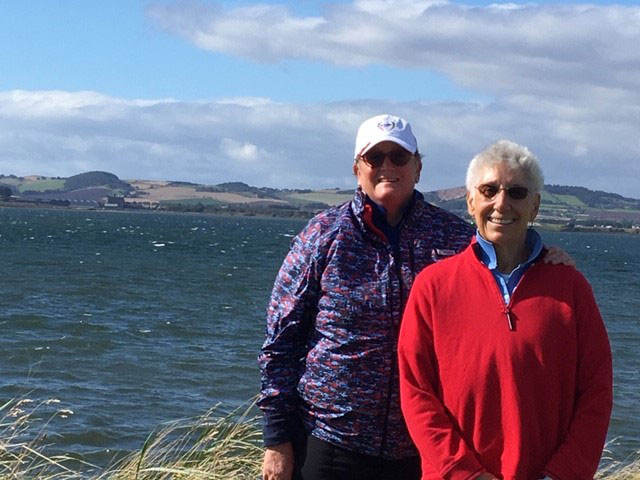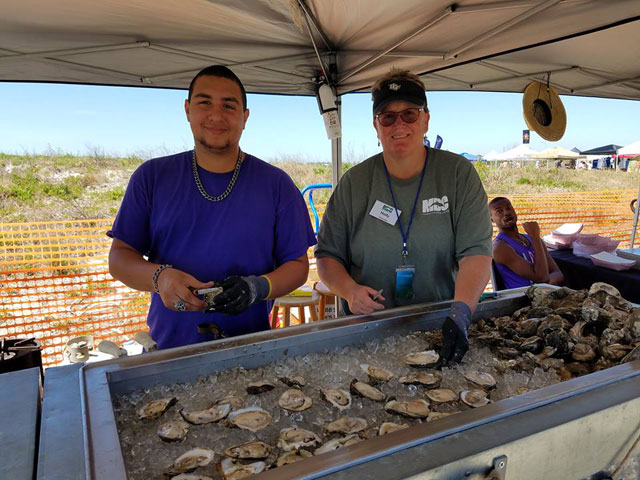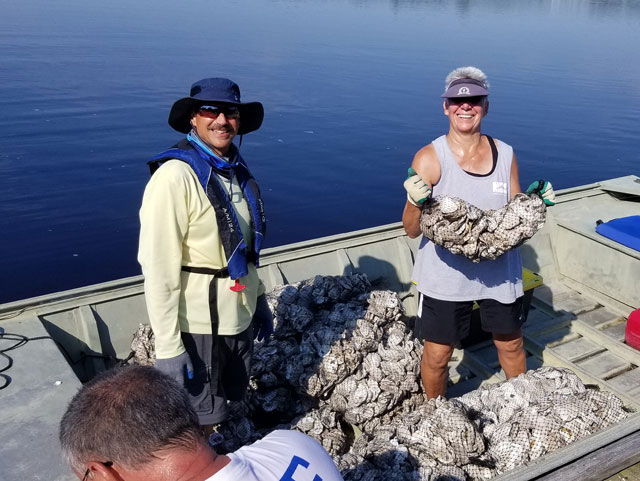If it requires getting dirty, wet, sweaty or coming nearly face to face with nature, you can count on Marine Discovery Center volunteers Cheryl Hood and Holly Perpall to be right there in the mix. You might even see them in the MDC tent engaging with the public at street festivals and inviting others to get involved.
The two have volunteered at the Marine Discovery Center since 2016 and have found satisfaction in both conservation and public outreach. Read about them in our November Volunteer Spotlight with MDC staff writer Lisa Mickey:
Q: Where did you grow up?
Cheryl: My father and stepfather were in the U.S. Navy, so I was born in Mississippi, moved to the Florida Panhandle, and around age 9, moved to Central New Jersey when my stepfather got a job there. My father and cousins are all still in Alabama, but I consider myself a Jersey girl.
Holly: I grew up in Falmouth, Mass., on Cape Cod. My dad was also in the military, but he retired on Cape Cod.
Q: When did you move to Florida?
Holly: Cheryl and I came down to Florida in 2012 and rented until we bought a house in Port Orange.
Q: Are you both still working or have each of you retired?
Cheryl: I’m retired. In my career, I worked mostly in sales in everything from hospital and medical sales to professional liability insurance and medical malpractice insurance. In my last job here before I retired in 2014 at the age of 57, I worked as a licensed practical nurse.
Holly: I retired in 2015. For most of my career, I worked for Merck Pharmaceuticals as a Ph.D. chemist in research and development, and later in international testing and problem solving. I took an early retirement from Merck when I came down here. I was recruited to work as head of quality for DaVita Laboratories in Deland. They do the testing for dialysis patients all over the country, so that was where I ended my career.
Q: What is your educational background?
Cheryl: I’m a Rutgers University graduate with a bachelor’s of science degree in animal science and biology. I was focused on pre-veterinary medicine studies and was always interested in animals and the environment. In 1972, I was in the first class from Rutgers to have women graduates. It used to be Rutgers College for men only and was an agriculture school.
Holly: I was an undergraduate at Boston College and earned my Ph.D. at the University of Massachusetts at Amherst.
Q: How did you start volunteering at MDC?
Holly: As a scientist and finding myself with so much free time on my hands after I retired, I wanted to do something in an area that would interest me. Growing up on Cape Cod and near premier international science organizations for oceanography and marine biology, I wanted to find something like that here as a volunteer. When I was in graduate school, I considered going to school for oceanography. So, I guess it’s sort of an unmet interest of mine. I remember seeing the sign for the Marine Discovery Center while I was still working.
As soon as I retired, we did some reading and learned about the monthly volunteer orientation program at MDC. We found there were all kinds of things we wanted to get involved in, especially the restoration work outdoors. I spent my youth swimming, sailing and fishing on the Cape and was a lifeguard for seven years, so it was a natural fit. Both of us knew that when we finished working, we wanted to do something as volunteers. I knew I wanted to give back from a science and environmental perspective and be around others who share common interests.
Q: What kind of things have you done at MDC as volunteers?
Cheryl: We do the oyster bagging because we love physical labor and being outdoors. We’ve also done coastal restoration, mangrove planting, Brazilian pepper eradication and the programs with MDC and the University of Central Florida, as well as horseshoe crab surveys and diamondback terrapin surveys.
Holly: We also did a lot of clearing, planting and maintenance on Discovery Island. I had an opportunity last summer to do birding surveys with a UCF graduate student. I’m an analytical chemist, so I was doing the data collection. We were watching for birds that used oyster reefs out on the lagoon. We didn’t see American Oystercatchers, but we saw a lot of other foraging and resting birds. That’s been one of my favorite things that I have done. I also enjoy the restoration work with the oyster bags and the plantings.
Q: You both have science backgrounds, so this sounds like a great fit for you.
Cheryl: It is. I worked for a veterinarian for 10 years from junior high school through college, so the whole animal-science aspect of it has always been special to me.
Q: What do you enjoy most about volunteering at MDC?
Cheryl: Working with the other volunteers. We’re motivated to do the right things and we’re all like-minded.
Holly: We have a really good group of volunteers and we do a lot of stuff together.
Q: You could be relaxing and enjoying your retirement. Why do you spend your time volunteering?
Cheryl: We still do other things, but volunteering is part of what we enjoy doing. Plus, when you are out working in the environment, we get to see birds, dolphins and manatees. We get to take the rides on boats and in kayaks and we get to learn about plants and what’s happening in the lagoon.
Holly: We both love working at something and seeing the fruits of our labor. It’s pretty neat to be able to say our group made 350 oyster bags or we rebuilt a quarter-mile of shoreline and planted a bunch of mangroves and cord grass. I get great satisfaction out of that.
Q: Do you volunteer in other places?
Holly: We volunteer on the Symetra Tour [the pipeline professional golf tour for the Ladies Professional Golf Association, based in Daytona Beach] and at LPGA International as real-time scorers for tournaments held there.
Q: How about your hobbies when you’re not volunteering?
Cheryl: We play pickleball, golf and do yoga. We work out and go to the gym twice a week. We also take the dog to the dog beach at Smyrna Dunes Park.
Holly: We have a dog named Dallas and a cat named Brady, as in Tom. We also do lots of reading.
Q: What has been the highlight for you at MDC?
Cheryl: Lots of things, but the horseshoe crab surveys in October were amazing. We helped tag them to see where they are going as they move around. Obviously, horseshoe crabs are very important in the medical industry because of their importance to pharmaceutical companies. In any kind of survey, just to see what’s going on in the environment and how it impacts us, is very interesting.
Holly: We actually saw the first mating pair of horseshoe crabs of the season in October down in Canaveral National Seashore. It was very exciting. We saw the two crabs and tagged them.
Q: What excites you the most about being a part of MDC’s mission to educate others about the Indian River Lagoon?
Cheryl: Just seeing the shoreline improve and seeing the oyster bags being used for something. We’re also into the fund raising part of it. We help with the street festivals in the MDC tent. I was in sales, so I try to get some money coming in to help MDC. I also want to learn more about the education part of what MDC does.
Holly: We keep coming back to like-minded people. We’re both extremely concerned about what’s going on in the environment with the warming, rising sea level and the effects of the environment on fish and other animals. Cheryl and I stood at the top of the observation mound during the last Lagoonacy festival and looked out at the lagoon. Just to look at it and know that whatever we’re doing — whether it’s shoveling oyster shells or making bags — that in the end, there’s a possibility that restoration can occur wherever those oyster bags go down.





Follow Us!